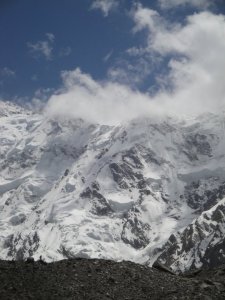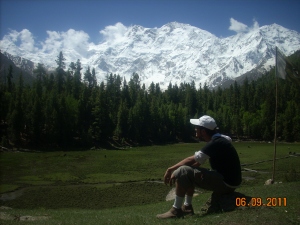NOTE: visit www.techenlife.com for more details regarding this blog and military aviation!!
“We never keep track,” one captain who had served there told me, “because if one counts, he completely forgets himself.” Tabish was established during a brutal firefight in September 1987, when the Pakistanis lost a crucial high post known as Qaid, then failed to push the Indians off the neighboring ridge. Last spring, when Captain Safdar was there, Tabish’s problems were aggravated by an avalanche of rocks that damaged several bunkers. Safdar apparently acquitted himself well during this crisis.
“Your leadership was exemplary,” the C.O. announced. “Young officers like you are the reason why we continue to dominate the enemy. Officers like you are the reason why we will ultimately prevail in this war.”
Life at such forward positions is brutal, and the Indians begrudgingly admit that the Pakistanis are tough customers. “They are sitting right underneath us on an 80-degree slope,” one Indian officer who was stationed above Tabish would tell me later. “We can throw grenades just like pebbles on top of them. It really takes guts to be there.” Captain Waqas Malik, 26, who served at Tabish, grimly described the hopeless feeling of such positions. “Once a ridge has been occupied,” he said, “you require a heart with the capacity of the ocean to accept the casualties you will incur in the taking of it.”
Each high post is manned by a squad of six to 18 men commanded by a young officer, usually a captain, and space is tight—a couple of fiberglass igloos, machine-gun platforms, a latrine, and a tiny area for religious worship. Each soldier is in charge of a particular weapon: light machine guns (LMGs), mortars, anti-aircraft guns. The men stay out of sight by day and stand watch by night.
Unlike mountaineers, who usually climb during the best weather, Siachen soldiers endure the worst the mountains can throw at them, year-round. Avalanches are frequent and terrifying; their thunder is so great that it’s often impossible to distinguish from shelling. Blizzards can last 20 days. Winds reach speeds of 125 miles per hour; temperatures can plunge to minus 60 degrees. Annual snowfall exceeds 35 feet. During storms, two or three men have to shovel snow at all times. If they stop, they will never catch up and the post will be buried alive.
“Sometimes in the winter, you see nothing but white,” said Captain Jamil Salamat, 24, the medical officer at Ghyari. “And you think, Maybe I will never make it back. That is the hugeness, and the hugeness has its own effect. It’s overwhelming. The snow is like an ocean up there.”
In such extreme cold, the single most important resource is kerosene. Known as “K2 oil,” it is used for cooking, melting snow for water, thawing out frozen guns, and keeping warm. It gives off a noxious smoke that coats the igloos with grime; for months after they descend, soldiers cough up black gunk.
Survival under these conditions requires specialized equipment. There are 112 separate items in a Pakistani soldier’s high-altitude kit, including two types of oxygen canisters, three models of ice axes, three kinds of rope, 29 sizes of pitons, five different pairs of gloves, three types of socks, a puffy white down suit rated to minus 60, and a black plastic”nuclear-biological-chemical warfare face mask.” The Pakistani gear that I saw seemed to be generally low-quality stuff; most of it carried the brand name Technoworld, which no one I spoke to in the outdoor industry had ever heard of. In contrast, Indian soldiers get state-of-the-art gear from a wide range of highly specialized Western firms like Koflach, Asolo, and Black Diamond
The monetary cost of these posts is enormous. A liter of kerosene that goes for 19 rupees in Rawalpindi costs Pakistan more than 650 rupees by the time it’s been hauled to 19,000 feet. (On the Indian side, almost every pound of supplies, including the artillery pieces, is flown in by helicopter because there are no roads on the glacier, pushing transportation costs ten times higher.) Each summer in the Ghyari sector alone, more than 35 Pakistani bases, gun positions, and fighting posts have to be stocked with some 2,000 tons of ammunition, rations, and fuel. This material is freighted to Ghyari by truck and hauled up the ice on mule and donkey trains. To prevent snowblindness, the pack animals are equipped with specially made glacier goggles. Sometimes they stumble and plummet into the crevasses. “They scream for an hour until they freeze to death,” one of the muleteers told me. “It is terrible to hear.”
Over 90 percent of the casualties on both sides are caused by weather, terrain, and what mountaineers call “objective dangers.” Above 18,000 feet, the human body cannot acclimatize and simply starts to deteriorate. Soldiers fall ill, lose their appetites, can’t sleep, and have problems with memory. Severe frostbite—all it takes is touching a gun barrel with bare hands—can result in the loss of fingers and toes. The two most serious killers are HAPE (high-altitude pulmonary edema) and HACE (high-altitude cerebral edema). Men suffering from HAPE, an accumulation of fluid in the lungs, cough up a pink froth and can be dead in a matter of hours. With HACE, fluid leaks from oxygen-starved blood vessels in the brain, causing severe swelling, headaches, hallucinations, and dementia. Untreated, HACE can kill a man within 24 hours.
In settings like this, suffering is often transformed into legend. The Pakistanis tell of a post beyond Sia La, at nearly 22,000 feet, that is said to have three separate cracks in the ice known as Three-Man Crevasse, Five-Man Crevasse, and Eight-Man Crevasse—each named for the number of men who died falling in. Soldiers talk of men losing their minds and leaping from the posts to their deaths. Some say their tormented cries can be heard in the wind over the peaks. And then there’s the story about the platoon killed in an early battle at Bilafond La, whose bodies froze into such grotesque positions that their corpses had to be hacked into pieces before they could be placed in helicopter panniers and brought down for return to their families.
Whether such tales are true is less important than what they symbolize about the futility of Siachen duty. “From what I’ve read, no one has ever been stupid enough to fight at this level before,” an officer at Ghyari remarked one afternoon when none of his colleagues were within earshot. “I hope it won’t be repeated again, because it’s a waste. A big, bloody waste.”
THE ARTILLERY FIRE HAD BEEN so fierce during the summer of 2002 that the Pakistani top brass delayed our trek to the front. But on our third day at Ghyari, they gave the go-ahead: We would be escorted by a squad of eight soldiers who had been ordered to relieve Captain Yasin Rafiq, the commander of a post called Sher.
Sher is perched at 19,600 feet on a ridge at the head of the Chumik Glacier, a short, steep tributary that comes crashing down into the Bilafond Glacier from the northeast and is one of the few Pakistani positions on the Saltoro that commands the high ground. It took us three days to hike there. On the third day, we reached a field of metal shards from exploded Indian artillery shells. Soaring above us was a huge crescent-shaped saddle. To get to its crest—where we could see the tiny black spot that was Sher—we had to ascend a thousand-foot snow-and-ice wall, pulling ourselves up on fixed ropes.
At the top, we caught our breath beside an 81mm mortar tube, then stepped into the post itself. Sher is only about 12 feet wide and 40 feet long. On one side are two fiberglass igloos where the men eat, cook, and sleep. On the other are a hulking 14.5mm Chinese-made anti-aircraft gun, a machine-gun bunker, and, higher up the ridge, a tiny observation post. We hobbled across 12 feet of frozen mud, stepped up to a stretch of rope serving as a guardrail, and stared down a 3,500-foot drop to the Indian front lines.
We were greeted by Captain Yasin, 29, who had been at his post for 82 days. Yasin pointed out an Indian supply base less than three miles away on the glacier below (from this distance, it was a brown spot on the ice), an Indian seasonal observation post (which we couldn’t see), and an Indian helicopter route. He announced grandly that this was the first time foreigners had been permitted to visit Sher.
Above the post, the ridge rose to a massive double peak called Naveed Top. In April 1989, the Indian army launched a mission known as Operation Ibex; its aim was to capture this peak and force the Pakistanis to vacate the entire upper portion of the Chumik Glacier. Three teams of Pakistani soldiers attempted to reach the summit to thwart the Indian operation and failed; one team was wiped out by an avalanche, the others halted by overhanging seracs. A last-ditch decision was made to airlift troops to a point just below the top of the 22,185-foot mountain using French Lama helicopters designed to fly no higher than 21,000 feet.
The air was so thin, the pilots feared they would crash if they attempted to hover. So after stripping as much excess weight as they could, they used a maneuver called a “running drop,” which required an individual soldier dangling from the bottom to be dropped onto the peak as they passed over. The first to make it was a 29-year-old lieutenant named Naveed-ur-Rehman. He was soon joined by a sergeant named Mohammed Yakub. But then a storm blew in and both men were forced to huddle on the mountain without supplies for two nights.
“The wind was so strong,” Naveed, who is now a major, later told me, “that we had to dig in our heels to avoid being carried away.” Over the next 40 days, six choppers relayed 86 soldiers and 38 tons of supplies onto the peak. Two Pakistani soldiers died and 30 were wounded during the defense of Naveed Top. That May—after the Indian advance was halted by a massive avalanche that killed a large number of their troops—both sides agreed to demilitarize the summit.
Or so say the Pakistanis. To this day, the Indian army denies that any of this ever happened.
That evening, after the sun went down, the men at Sher all crammed into the largest igloo for what Captain Yasin called “after-dinner discussion.” It began with the sergeant, or havildar, thumping out a beat on an empty jerry can using a carabiner. The men began singing in Pashto, while Yasin—who is a hafiz, which means he has memorized the entire Koran—translated for me. It was a song about the cruelty of beautiful women, he said, about the rigidity of their hearts and the shallowness of their sincerity. Then the men shifted to Urdu, the language of the Mogul poets and Sufi mystics. They sang of how the affection between men and women has the power to transcend social caste. They sang about an aspect of love so complex and subtle that Yasin said it was impossible to translate and advised me to just sit back and enjoy the music.
After the singing stopped, Yasin and I stepped outside. The moon was surrounded by a rainbow-colored ring, harbinger of a storm, and the peaks were cast in a milky glow. From the shadows came a disembodied voice in Urdu.
“Beautiful night, sir.”
“Mehboob, is that you?” said Yasin to a lone sentry who had volunteered to stand watch so that his companions could hobnob with the guests.
































